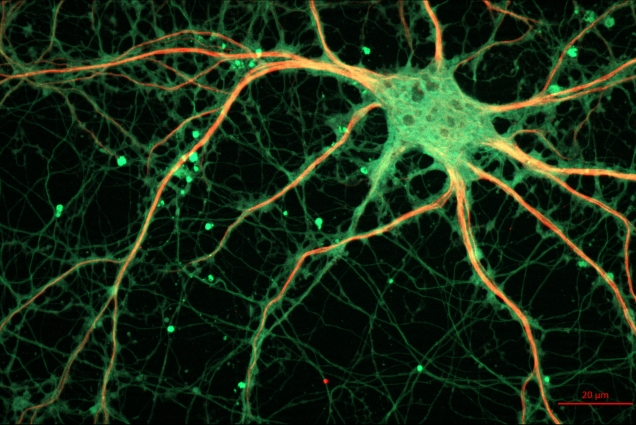Nervous System Development and Function
Whitehead Institute researchers are making important insights into the biology of the brain, from how it develops to what goes awry in neurodegenerative diseases and neurodevelopmental disorders.

Oligodendrocyte image.
Olivia Corradin/Whitehead Institute
The brain is a complex organ, and much of its biology remains to be discovered. Teasing out the specific mechanisms that help a healthy brain develop, or that may go awry in disease, can be a challenge—especially given that researchers have no real access to patients’ brain cells over the course of development or disease. Our researchers are developing new solutions for how to investigate the brain and discovering many important, informative aspects of brain biology.

Pixabay
One challenge of brain research is the brain’s inaccessibility. Our researchers are advancing technologies and processes to build better models enabling a fuller picture of brain and central nervous system development. They are inventing ways to make stem-cell-derived brain cells behave more like cells in a live brain, and using brain organoids, three-dimensional assemblies of cells that form an approximation of brain tissue, in order to study cells in conditions that more closely match their environment in the body.

ZEISS Microscopy / CC BY 2.0.
Scientists at Whitehead Institute are studying typical brain and nervous system development, as well as diseases and disorders of the brain, including neurodegenerative and mental health disorders. In order to understand these processes, they are looking at the roles played by individual genes, networks of genes and genetic regulators, and intra- and intercellular pathways. For instance, our researchers study diseases like Zika virus disease, which affects brain development and head size in a developing fetus, in order to learn more about the disease and also in order to gain insights into brain development. Our researchers are also working on approaches that might one day be used to treat these diseases, such as epigenetic therapies for neurodevelopmental disorders Rett Syndrome and Fragile X and neurodegenerative prion diseases.

Devon Svoboda
In neurodegenerative diseases, such as Alzheimer’s, neurons can be negatively impacted by the aggregation of misfolded proteins and, potentially, misfolded RNAs, that build up in the cells and disrupt normal processes. Whitehead Institute researchers are investigating the causes and characteristics of these disease-linked aggregates.

Zoë Helene Kindermann, licensed under CC-BY-SA-4.0
Many animals have evolved to enter dormant states, such as hibernation and torpor, in which they profoundly reduce their body temperature and metabolism in order to conserve energy and survive periods of environmental stress or starvation. Entering these states may slow down tissue damage, disease progression, and aging, and so inducing stasis could lead to health benefits. Our researchers study how the brain regulates these states, including entry into them.

How do we choose what to do in uncertain situations? Our researchers are studying the brain circuitry that underlies decision-making. They are looking at decision-making in both mice and humans, and simulating disease conditions to see how that affects the process.




